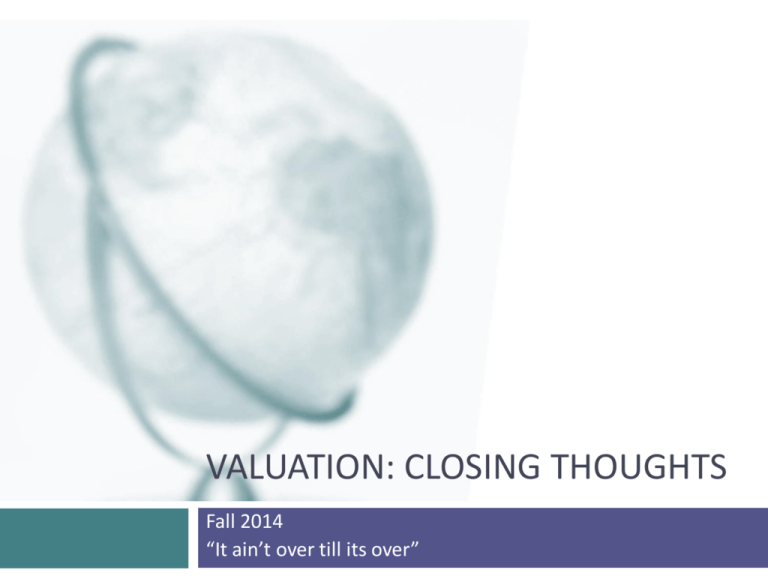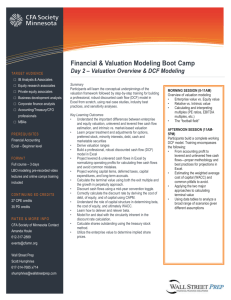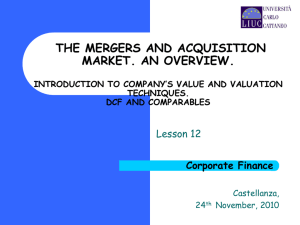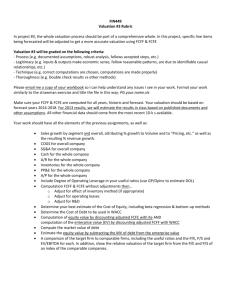Valuation: Introduction - NYU Stern School of Business
advertisement

VALUATION: CLOSING THOUGHTS Fall 2014 “It ain’t over till its over” Back to the very beginning: Approaches to Valuation Discounted cashflow valuation, where we try (sometimes desperately) to estimate the intrinsic value of an asset by using a mix of theory, guesswork and prayer. Relative valuation, where we pick a group of assets, attach the name “comparable” to them and tell a story. Contingent claim valuation, where we take the valuation that we did in the DCF valuation and divvy it up between the potential thieves (equity) and the victims of this crime (lenders) 2 Intrinsic Valuation: The set up 3 Dante meets DCF: Nine layers of valuation hell.. And a bonus layer.. 4 Layer 1: Base Year fixation…. You are valuing Exxon Mobil, using the financial statements of the firm from 2008. The following provides the key numbers: Revenues EBIT (1-t) Net Cap Ex Chg WC FCFF $477 billion $ 58 billion $ 3 billion $ 1 billion $ 54 billion The cost of capital for the firm is 8% and you use a very conservative stable growth rate of 2% to value the firm. The market cap for the firm is $373 billion and it has $ 10 billion in debt outstanding. a. How under or over valued is the equity in the firm? b. Would you buy the stock based on this valuation? Why or why not? 5 Layer 2: Taxes and Value Assume that you have been asked to value a company and have been provided with the most recent year’s financial statements: EBITDA 140 - DA 40 EBIT 100 Free Cash flow to firm Interest exp 20 EBIT (1- tax rate) -(Cap Ex – Depreciation) Taxable income 80 - Change in non-cash WC Taxes 32 =FCFF Net Income 48 Assume also that cash flows will be constant and that there is no growth in perpetuity. What is the free cash flow to the firm? a. b. c. d. e. f. 88 million (Net income + Depreciation) 108 million (EBIT – taxes + Depreciation) 100 million (EBIT (1-tax rate)+ Depreciation) 60 million (EBIT (1- tax rate)) 48 million (Net Income) 68 million (EBIT – Taxes) 6 Layer 3: High Growth for how long… Assume that you are valuing a young, high growth firm with great potential, just after its initial public offering. How long would you set your high growth period? < 5 years 5 years 10 years >10 years 7 Layer 4: The Cost of Capital The cost of capital for Chippewa Technologies, a US technology firm with 20% of its revenues from Brazil, has been computed using the following inputs: 8 The Correct Cost of Capital for Chippewa 9 Layer 5: The price of growth.. You are looking at the projected cash flows provided by the management of the firm, for use in valuation What questions would you raise about the forecasts? 10 Layer 6: The “fixed debt ratio” assumption You have been asked to value Hormel Foods, a firm which currently has the following cost of capital: Cost of capital = 7.31% (.9) + 2.36% (.1) = 6.8% You believe that the target debt ratio for this firm should be 30%. What will the cost of capital be at the target debt ratio? Which debt ratio (and cost of capital) should you use in valuing this company? 11 Layer 7: The Terminal Value a. b. c. The best way to compute terminal value is to Use a stable growth model and assume cash flows grow at a fixed rate forever Use a multiple of EBITDA or revenues in the terminal year Use the estimated liquidation value of the assets You have been asked to value a business. The business expects to $ 120 million in after-tax earnings (and cash flow) next year and to continue generating these earnings in perpetuity. The firm is all equity funded and the cost of equity is 10%; the riskfree rate is 3% and the ERP is 7%. What is the value of the business? Assume now that you were told that the firm can grow earnings at 2% a year forever. Estimate the value of the business. 12 Layer 8. From firm value to equity value: The Garnishing Effect… For a firm with consolidated financial statements, you have discounted free cashflows to the firm at the cost of capital to arrive at a firm value of $ 100 million. The firm has A cash balance of $ 15 million Debt outstanding of $ 20 million A 5% holding in another company: the book value of this holding is $ 5 million. (Market value of equity in this company is $ 200 million) Minority interests of $ 10 million on the balance sheet What is the value of equity in this firm? How would your answer change if you knew that the firm was the target of a lawsuit it is likely to win but where the potential payout could be $ 100 million if it loses? 13 Layer 9. From equity value to equity value per share You have valued the equity in a firm at $ 200 million. Estimate the value of equity per share if there are 10 million shares outstanding.. How would your answer change if you were told that there are 2 million employee options outstanding, with a strike price of $ 20 a share and 5 years left to expiration? 14 Layer 10. The final circle of hell… Kennecott Corp (Acquirer) Carborandum (Target) Cost of Equity 13.0% 16.5% Cost of Capital 10.5% 12.5% 15 YOUR NUMBERS/FINDINGS “The truth shall set you free”. The Models You Used in DCF Valuation Model used Dividend Discount 4% FCFE 11% FCFF 85% 17 What you found… DCF Value vs Market Price 25. Average Median Low High 20. % under or over value 14.26% -2.01% -45.87% 497.82% Axis Title 15. 10. 5. 0. Undervalued Undervalued 33- Undervalued 10- Undervalued 0more than 50% 50% 33% 10% Overvalued 010% Overvalued 10- Overvalued 50- Overvalued more 50% 100% than 100% Axis Title 18 The most undervalued stocks… 19 The Most Overvalued stocks are... 20 The ultimate test… Did undervalued stocks make money? Performance of Recommenda ons 20.00% 15.00% 10.00% Buy S&P 500 Sell 5.00% 0.00% Spring 1995 Spring 1997 Spring 1999 Spring 2001 Spring 2003 Spring 2005 -5.00% 21 More on the winners... About 60% of all buy recommendations make money; about 45% of sell recommendations beat the market. The average return on buy recommendations was about 4% higher, on an annualized basis, than the average return on sell recommendations. The excess returns on buy recommendations on small cap and emerging market companies is higher than the excess returns on large market cap companies, with higher mistakes in both directions on the former. There are two or three big winners in each period, but the payoff was not always immediate. Buying Apple in 1999 would have led to negative returns for a year or more, before the turnaround occurred. Stocks that are under valued on both a DCF and relative valuation basis do better than stocks that are under valued on only one approach. 22 Relative Valuation: The Four Steps to Understanding Multiples Anna Kournikova knows PE…. Or does she? 8 times EBITDA is not always cheap… Too many people who use a multiple have no idea what its cross sectional distribution is. If you do not know what the cross sectional distribution of a multiple is, it is difficult to look at a number and pass judgment on whether it is too high or low. You cannot get away without making assumptions In use, the same multiple can be defined in different ways by different users. When comparing and using multiples, estimated by someone else, it is critical that we understand how the multiples have been estimated It is critical that we understand the fundamentals that drive each multiple, and the nature of the relationship between the multiple and each variable. There are no perfect comparables Defining the comparable universe and controlling for differences is far more difficult in practice than it is in theory. 23 The Multiples you used were ... 25 DCF vs Relative Valuation Average Median Low High % under or over value 106.52% 102.16% 0.E+0 324.57% 26 Most undervalued on a relative basis… Company Name RadioShack Samsung Electronics Chesapeake Energy Lululemon Athletica inc. (LULU) Commerzbank AG Commerzbank AG Tesla Motor Inc. Pandora Wynn Resorts, Limited (WYNN) Clear Channel Outdoor Holdings (NYSE: CCO) Tata Motors Limited (BSE:500570) Garuda Indonesia Lululemon (LULU) Kohl's Corporation Incyte Criteo Quest Diagnostics, Inc. (DGX) Price $1.47 $1,346,000.00 $26.59 $43.77 11.70 11.70 € $182.26 22.62 $200.49 $8.14 427.5 IDR456 $43.77 $54.75 $52.08 $26.89 $57.18 Relative Value % under valued Recommendation 4.422 -66.76% Buy $3,921,212.00 -65.67% Buy $77.26 -65.58% Buy $126.79 -65.48% Buy 29.76 -60.69% Buy 29.76 € -60.69% Buy $369.76 Sell -50.71% 41.71 -45.77% Buy $354.84 -43.50% Buy $12.99 -37.34% Buy 645.93 -33.82% Buy IDR649 -29.74% Buy 61.98 -29.38% Buy $76.95 -28.85% Buy $71.05 -26.70% Buy 36.05 -25.41% Buy $72.58 -21.22% Buy 27 Most overvalued on a relative basis… Company Name J.C.Penny ARM Holdings plc (ARM) Aerovironment GrubHub Amazon (AMZN) Yelp Dynegy (DYN) Netflix Inc. 3D Systems (NYSE: DDD) Tesla Motors Moncler Price $8.80 £26.63 $32.29 31.18 $292.24 52.13 $31.89 $328.55 $47.64 179.00 12.45 BHP Billiton $69.51 Fortinet Inc. Ocado Group $20.36 3.18 J. C. Penney Company, Inc. (NYSE:JCP) Rosetta Stone Keurig Green Mountain, Inc. (NASDAQ:GMCR) % under valued $0.26 3284.62% £8.47 214.40% $10.38 211.08% 206.89% 10.16 $108.93 168.28% 156.92% 20.29 $13.52 135.87% $153.06 114.65% 99.08% $23.93 106.00 68.87% 7.54 65.12% $42.55 63.36% $13.00 56.62% 2.04 55.88% 5.93 49.41% 45.37% 7.89 75.35 43.95% Relative Value $8.86 11.47 $108.47 Recommendation Sell Sell Sell Sell Sell Sell Sell Sell Sell Sell Sell Sell Sell Sell Sell Sell Sell 28 Contingent Claim (Option) Valuation Options have several features They derive their value from an underlying asset, which has value The payoff on a call (put) option occurs only if the value of the underlying asset is greater (lesser) than an exercise price that is specified at the time the option is created. If this contingency does not occur, the option is worthless. They have a fixed life Any security that shares these features can be valued as an option. Number of firms valued using option models = 8 Median Percent increase in value over DCF value= 55% 29 Value Enhancement… You too can do it! 30 Alternative Approaches to Value Enhancement Maximize a variable that is correlated with the value of the firm. There are several choices for such a variable. It could be The advantages of using these variables are that they an accounting variable, such as earnings or return on investment a marketing variable, such as market share a cash flow variable, such as cash flow return on investment (CFROI) a risk-adjusted cash flow variable, such as Economic Value Added (EVA) Are often simpler and easier to use than DCF value. The disadvantage is that the Simplicity comes at a cost; these variables are not perfectly correlated with DCF value. 31 The bottom line Old wine in a new bottle: All discounted cash flow models (cost of capital, APV, EVA, Excess return models) are all variants of the same model and, done right, should yield the same value. No magic bullets: Value enhancement is hard work. There are no “short cuts” and adopting EVA, CFROI or any other measure will not increase value. Tying compensation systems to a measure is a recipe for game playing: If you tie management compensation to EVA, for instance, can lead to: The Growth trade off game: Managers may give up valuable growth opportunities in the future to deliver higher EVA in the current year. The Risk game: Managers may be able to deliver a higher dollar EVA but in riskier businesses. The value of the business is the present value of EVA over time and the risk effect may dominate the increased EVA. The capital invested game: The key to delivering positive EVA is to make investments that do not show up as part of capital invested. That way, your operating income will increase while capital invested will decrease. 32 Acting on valuation: It is not just an academic exercise a. b. c. I am not sure yet: Uncertainty is not a shield against action. If you wait until you feel “certain” about your valuation, you will never act. All believers now? Ultimately, you have to believe in some modicum of market efficiency. Markets have to correct their mistakes for your valuations to pay off. The law of large numbers: Assuming your valuations carry heft, you are far more likely to be right across many companies than on any individual one. 33 Your recommendations were to.. 34 Choices…Choices…Choices… Valuation Models Asset Based Valuation Discounted Cashflow Models Relative Valuation Liquidation Value Equity Stable Current Contingent Claim Models Sector Two-stage Three-stage or n-stage Equity Valuation Models Normalized Earnings Book Revenues Value Sector specific Option to liquidate Young firms Equity in troubled firm Undeveloped land Firm Valuation Models Patent Dividends Free Cashflow to Equity Option to expand Firm Market Replacement Cost Option to delay Cost of capital approach APV approach Undeveloped Reserves Excess Return Models 35 Picking your approach Asset characteristics Marketability Cash flow generating capacity Uniqueness Your characteristics Time horizon Reasons for doing the valuation Beliefs about markets 36 What approach would work for you? a. b. c. As an investor, given your investment philosophy, time horizon and beliefs about markets (that you will be investing in), which of the the approaches to valuation would you choose? Discounted Cash Flow Valuation Relative Valuation Neither. I believe that markets are efficient. 37 Some Not Very Profound Advice Its all in the fundamentals. The more things change, the more they stay the same…. Focus on the big picture. Don’t sweat the small stuff and don’t get distracted. Anecdotes mean little and experience does not equal knowledge. Keep your perspective. It is only a valuation. In investing, luck dominates skill and knowledge. 38








